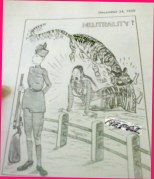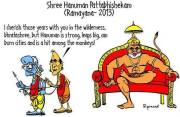Rise and Rise of Political Cartoons in India
Posted by chimeki on October 7, 2013
Political cartoons are back in India. They are not just back but have become powerful enough to disrupt Parliament, force authority to resign, land their creators to jail and terrify the people who were once symbols of terror!
Editorial or political cartoons in free India have an exemplary history. In the initial years they dared to speak what critics refrained from asserting. The father of Indian political cartooning, Kesava Shankara Pillai, popularly known as Shankar, highlighted the complexities of  India’s positioning against then realpolitik in simplest ways possible. Many a times his cartoons influenced the decision making. One of his cartoons I like the most is on Nepal. In the cartoon, he showed that India could not remain aloof to rising anti Rana feeling of Nepalese. In a few days of its publication India decided to mediate. The result: end of Rana dynasty or Ranashahi.
India’s positioning against then realpolitik in simplest ways possible. Many a times his cartoons influenced the decision making. One of his cartoons I like the most is on Nepal. In the cartoon, he showed that India could not remain aloof to rising anti Rana feeling of Nepalese. In a few days of its publication India decided to mediate. The result: end of Rana dynasty or Ranashahi.
Shankar sketched more than 1400 cartoons mostly during Jawaharlal Nehru’s era. His cartoons, then, had become so important that it is said Nehru used to wait for Shankar’s Weekly to learn about the flaws in the works of his government!
Recently, in January 2012, India again witnessed a rise in publication of vocal political cartoons. Irony is, this phase too began with a cartoon of Shankar! The cartoon Shankar made in 1949, highlighting the slow speed in constitution making suddenly put hold on Parliament’s work. The very cartoon which speeded up the constitution making process culminating in creation of Parliament was considered inappropriate by the members of Parliament and ordained to be removed from the text books!
In September 2012, cartoonist Aseem Trivedi was arrested on charges of sedition. His ‘offense’ was ‘insulting the Indian Parliament’. Former editor of Outlook Weekly Vinod Mehta mocked the low IQ shown by the parliamentarians by suggesting, ‘indeed, if he has to be punished, punish him for terrible and crude sketching.’
We are now in the third phase of political cartooning. The cartoonists, R. Prasad, Satish Acharya, Irfan, Keshav, Surendra and several other unknown and unknown cartoonists have taken up lead in inspiring political discourse in print and web media. They have filled the vacuum left by liberal intellectuals. Here are my three favorite cartoons which reflect the shift in Indian political discourse with clarity. (V.S)
















































Leave a comment